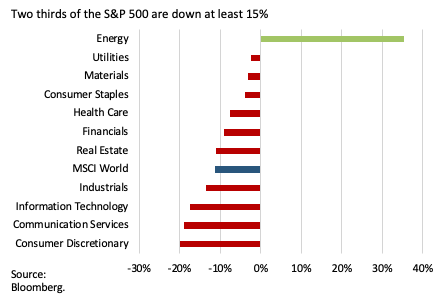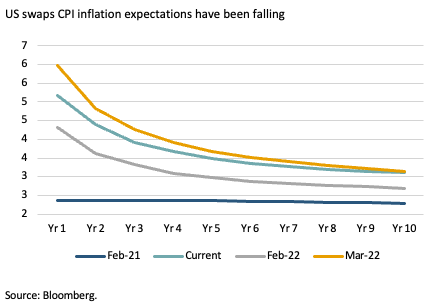The outlook for equities

LGT Crestone
Note: This article was written on May 6.
Across many asset classes—global equities, fixed income and cash—real returns have been deeply negative over 2022, as persistent inflationary pressures (compounded by the Russia-Ukraine conflict) have left most central banks seemingly behind the curve in their monetary policy settings. Higher interest rates are coming at a time when global growth has slowed (US Q1 GDP was negative), creating a perfect storm for investors and raising the prospect of a stagflationary backdrop for equity markets.
In this article, we explain that the intersection of peak inflation, peak US Federal Reserve (Fed) hawkishness, and peak interest rates will govern the direction of equity markets in H2 2022. We also revisit how investors should be positioning their portfolios’ exposure to technology stocks.
Is a stagflationary backdrop likely?
Although stagflation is not our central case scenario, performance through the first four months of the year is consistent with performance in previous periods of recession. Indeed the ‘internals’ of equity markets are already ’tilting’ late cycle. Defensive sectors, such as utilities, consumer staples, healthcare and real estate, have all been relative outperformers, as is typical during recessions. Furthermore, the NASDAQ is in a bear market, as is 50% of the S&P 500 index, with two thirds of the constituents down at least 15%.
In our opinion, it is the intersection of peak inflation, peak Fed hawkishness and peak interest rates that will determine the direction of equity markets over H2 2022. In combination with company earnings and margins, it is likely that these issues will be front of mind for investors.

Is it possible we are at, or close to, peak inflation?
On the first issue—peak inflation—it is possible that we are at, or close to an inflection. China’s zero-tolerance approach to COVID-19 has added volatility to global supply chains, on top of unprecedented raw material volatility arising from the conflict in Ukraine. Despite this, breakeven inflation rates (i.e. the measure of expected inflation derived from comparing nominal bonds to inflation-protected bonds) hit their recent highs near the end of March and have trended lower since then. Furthermore, CPI swaps inflation expectations, although elevated compared with year-ago levels, have also been falling over the past several months.
So, if inflation is at, or close to, peak, why have equity markets not responded? We highlight two reasons:
- Firstly, although near-term inflationary expectations have subsided, longer-term expectations have not fallen by as much, prompting questions about whether inflationary expectations are becoming embedded over the longer term. Combined with record job openings to unemployed ratios, it is prompting investors to question just how ‘persistent’ elevated inflation may be. Indeed, Fed Chairman Powell commented this week that he expects to see “inflation flattening out…not necessarily declining yet.”
- Secondly, peak inflation does not necessarily mean peak hawkishness—or, at least, not yet. Futures markets are currently pricing in a February 2023 Fed funds rate of 2.92%. This compares to the 2.55% rate priced in at the end of March, despite inflationary expectations receding over that time.

How do rising rates affect equities?
Finally, and perhaps most importantly, interest rates. The US 10-year bond appears to have broken out of a period of delivering consistently lower yields. This is critically important because the US 10-year bond yield is the financial instrument that underpins discount rates used to value cashflows. All things equal, a higher discount rate lowers the value of future cashflows and therefore the valuation ascribed to companies. More simplistically, the 3% yield that investors can receive for a risk-free investment is now competitive vis-à-vis the dividend yields, earnings yields, or free cashflow yields that investors generate by holding equities. For example:
- The relative dividend yield of the MSCI World index versus the US 10-year bond yield is at its lowest levels in a decade, at -74bps.
- The relative earnings yield of the MSCI World index versus the US 10-year bond yield is trading at close to its lowest levels in a decade, around 350 basis points (bps).
- The relative free cashflow yield of the MSCI World index versus the US 10-year bond yield is around 290bps. This is above prior lows but still narrow when viewed against the average 340bps premium over the past decade.
At a single stock level, this is best illustrated by Microsoft. In terms of equities, its AAA-rated balance sheet (one of only two companies in the world) has often been viewed as an equity market equivalent to a risk-free investment. Over the past five years, investors have been able to generate a free cashflow yield averaging 4.2%—or relative to US 10-year bond yields, an average yield pick-up of 230bps. With bond yields now closer to 3%, that yield pick-up has compressed to just 60bps.
The implication is significant. Global investors, starved of yield, have aggressively bid up equities with long-dated cashflows because the alternatives (government bonds) were not competitive. Furthermore, the yield on investment grade bonds relative to the dividend yield on the S&P 500 is now at its highest level in a decade. Where long-term interest rates trend over the next few years will be key to assessing valuations for equity markets.
Are current earnings estimates accurate?
This brings us to the final piece of the puzzle—earnings. Based on current estimates, the MSCI World 2023 price/earnings (P/E) ratio, which is around 15.6x, is below the 16x five-year average and in line with the 10-year average. In other words, the recent correction has rendered earnings-based valuation metrics seemingly fair (though not cheap) for the market at large. For Australia, its valuation is now trading one standard deviation from its five-year average, offering greater valuation protection and justifying our overweight stance.
The critical issue for investors is whether current earnings estimates are accurate. Put another way, will wages and raw materials cost pressures, and a consumer that no longer has fiscal or monetary support (notwithstanding strong cash surpluses) result in earnings and corporate profit margins that are lower than currently forecast? If that is the case, earnings-based valuation metrics will likely become more expensive than they appear. Conversely, if they prove resilient, then average valuations might find some buying support.
The almost completed US reporting season has been resilient thus far. According to FactSet, the blended earnings growth rate for the S&P 500 index is 7.1% (excluding Amazon, that growth rate would be 10.1%). Although 7.1% would mark the lowest earnings growth rate reported by the index since Q4 2020 (3.8%), it is actually higher than the 4.7% that was expected heading into the reporting period. For the S&P 500 index, 2022 earnings per share growth estimates are 9.5%, only marginally lower than the 9.9% expected in January.
How should investors be positioning exposure to tech?
For many investors, how to position their portfolio’s exposure to technology stocks is perhaps their biggest conundrum. Although many technology companies remain resilient businesses, with high returns on capital and strong balance sheets, valuations make many stocks vulnerable to any downturn in sentiment. Indeed, as we saw during the COVID-19 pandemic, the pull-forward of demand has left some stocks exposed to a revenue headwind (e.g. Netflix) or cost/margin challenges (e.g. Amazon). Of particular concern are the unprofitable segments of technology, where price-to-sales multiples have continued to contract. The median price-to-sales ratio in the Nasdaq 100 has moved back below 6x for the first time since May 2020. It peaked in November 2021 at 8.5x and is now lower than it was before the start of the pandemic (6.4x in December 2019). Over the past five years, however, that ratio has been as low as 4.5x, highlighting that significant valuation risk remains (a de-rate from 5.9x to 4.5x, assuming no change to revenues, is approximately 25%).
For the NASDAQ more broadly, although its current 2023 P/E of 22.6x is broadly in line with its five-year average, this is flattered by post-pandemic multiples that had expanded from previous highs of 22x to over 30x. If one considers five-year average multiples pre-pandemic (approximately 19x), current multiples look expensive rather than fair (a reversion to the mean implies a 15% contraction in multiples).
On a free cashflow basis, although a 4.3% free cashflow yield is in line with its average over the past five years, it only provides a 130bps premium to 10-year bond yields, which is well below the 270bps premium it has averaged over the same period. Highlighting the inherent difficulty when it comes to valuations, if investors were to demand an average free cashflow yield premium, the NASDAQ’s free cashflow yield would need to rise to roughly 5.5%. There are many ways this could be achieved. A 25% fall in the NASDAQ is one way!
Alternatively, a period of sideways performance, which allows free cashflows to grow, is also possible (i.e. equities need not always be rising or falling, they can go through periods of oscillation). Alternatively, if bond yields were to fall, it would improve the relative attractiveness of NASDAQ cashflows without a need for prices to fall.
As noted in February in our piece Trimming risk…still positive on the outlook when we took the decision to trim risk, “at this point in the cycle, we are confronted with 30-year high inflation (in the US and UK) and very high inflation elsewhere. And from the position of near-zero policy rates with central banks removing liquidity, there must be non-zero risk that a valuation correction comes more quickly.”
Unfortunately, valuation is more of an art than a science. When alternative investment opportunities yielded close to the zero-lower bound (or negative in Europe), the valuations on offer in certain segments of the market were seemingly justified. In the current environment where US bond yields are around 3% and German bond yields around 1% (the highest levels since 2015), ascribing the right valuation is even more difficult.
The best course of action is to be well diversified
In this period of volatility and adjustment, the best course of action is to remain well diversified within equities (by region, style and sector) and across asset classes, and to remain very cognisant of valuation risk. At a macro level, the key question for investors is whether peak inflation means a period of plateauing inflation or falling inflation. If it is the latter (which remains our central case), this will allow central banks to avoid taking interest rates to overly restrictive levels, giving equities scope to recapture some performance. If inflation remains elevated, the notion of peak hawkishness and what that means for the ultimate level of interest rates will be a headwind for equities—both at an earnings level (lower growth, higher debt refinancing costs) and valuation.
Align your investment with your values
The desire to invest responsibly has never been stronger. At Crestone, we work with a wide range of investors who are looking to align their investments with their values. Click the 'CONTACT' button below to get in touch with us.
1 topic

Todd joined Crestone in June 2017 and he is responsible for global equities investment and advice. He has over 15 years experience covering fixed income, Australian and global equities both domestically and internationally.
Expertise

Todd joined Crestone in June 2017 and he is responsible for global equities investment and advice. He has over 15 years experience covering fixed income, Australian and global equities both domestically and internationally.
